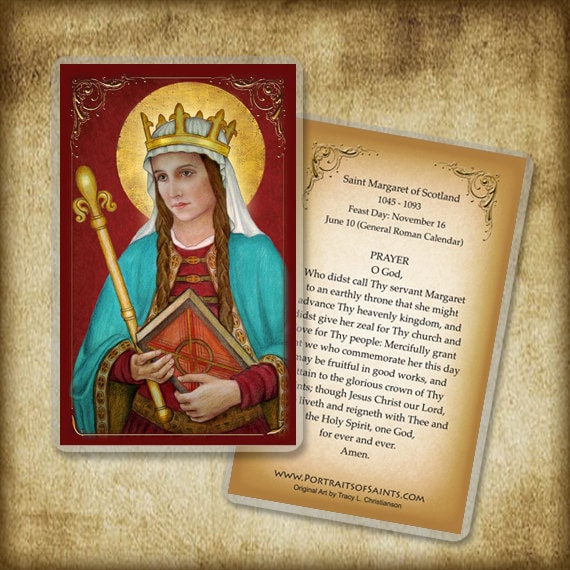Hari
OM
Story-day is for cultural exploration, puraanas and
parables and finding out about leading lights in spiritual philosophy.
St Margaret, Queen of Scotland
The
princess Margaret of Wessex was born in Hungary, daughter of the exiled Edward
of England. Edward had been exiled by Danish invader, Canute, when still very
young and he spent much time in Sweden then on to Hungary. Margaret and her
siblings grew up in Hungary under a strong religious ethos. She would have been
about 10 or 12 years of age when her father was recalled to England as
potential for his taking the throne on the death of Edward the Confessor. There
was all the usual dastardly and dark intrigue which goes with such stories and
it culminated in the death of Edward and the need for Margaret, her mother and
siblings, to escape from London. They headed North.
According to tradition, the widowed mother,
Agatha, decided to leave Northumbria
with her children and return to the continent. However, a storm drove their
ship north to Scotland, where they
sought the protection of King Malcolm III. The spot
where they are said to have landed is known today as St Margaret's
Hope, near the village of North
Queensferry. Malcolm was a
widower with two sons, Donald and Duncan. He would have been attracted by the
prospect of marrying one of the few remaining members of the Anglo-Saxon royal family. The marriage of Malcolm and Margaret took place some
time before the end of 1070. The couple had six sons and two daughters from
their union.
Margaret is considered to have had a
civilizing influence on her husband and the Scots in general. She instigated
religious reform, striving to make the worship and practices of the Church in
Scotland conform to those of Rome. She also worked to bring the Scottish Church practice in line with that of the continental church of her
childhood. Due to these achievements, she was considered an exemplar of the
"just ruler". (Her youngest son, later David I - also was
canonised.) Queen Margaret is depicted widely as a strong, pure, noble
character, who had very great influence over her husband, and through him over
Scottish history, especially in it ecclesiastical aspects. Her religion, which
was genuine and intense, was of the newest Roman style; and to her are
attributed a number of reforms in the Church of Scotland.
She attended to charitable works, serving
orphans and the poor every day before she ate, and washing the feet of the poor
in imitation of Christ. She rose at midnight every night to attend church
services. She invited the Benedictine order to establish a monastery at Dunfermline in Fife in 1072, and established ferries at Queensferry and North Berwick to assist pilgrims journeying from South of
the Firth of Forth to St. Andrews in Fife. A cave on the banks of the Tower
Burn in Dunfermline was used by her as a place of devotion and prayer. Amongst
her other deeds, Margaret also instigated the restoration of the monastery at Iona.
In
her private life, Margaret was as devout as she was in her public duties. She
spent much of her time in prayer, devotional reading and ecclesiastical
embroidery. Malcolm seems to have been largely ignorant of the long-term
effects of Margaret's endeavours, not being especially religious himself. He
was content for her to pursue her reforms as she wished, a testament to the
strength and affection inherent in their marriage.
This
bond is further emphasised by the fact that Margaret, weakened by illness from
long years of physical austerity and fasting, on hearing of her husband and
elder son's death in battle, also passed away, the news too much for her to
bear.
Margaret
was canonised in the year 1250 by Innocent IV, for her personal commitment, for
her religious reform and for her charity. Her feast day is November 16th. The
key examples set by Margaret were that she never expected anyone to practice
anything she did not do herself; that faith sustains one through much; that
charity and the service of all, regardless of status, is the noble act of a
spiritual being.

